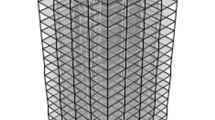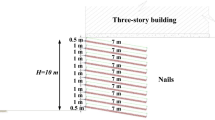Abstract
In this study, ground vibrations due to dynamic loadings from trains moving in subway tunnels were investigated using a 2.5D finite element model of an underground tunnel and surrounding soil interactions. In our model, wave propagation in the infinitely extended ground is dealt with using a simple, yet efficient gradually damped artificial boundary. Based on the assumption of invariant geometry and material distribution in the tunnel’s direction, the Fourier transform of the spatial dimension in this direction is applied to represent the waves in terms of the wave-number. Finite element discretization is employed in the cross-section perpendicular to the tunnel direction and the governing equations are solved for every discrete wave-number. The 3D ground responses are calculated from the wave-number expansion by employing the inverse Fourier transform. The accuracy of the proposed analysis method is verified by a semi-analytical solution of a rectangular load moving inside a soil stratum. A case study of subway train induced ground vibration is presented and the dependency of wave attenuation at the ground surface on the vibration frequency of the moving load is discussed.
Similar content being viewed by others
References
Andersen, L., Jones, C.J.C., 2006. Coupled boundary and finite element analysis of vibration from railway tunnels -a comparison of two- and three-dimensional models. Journal of Sound and Vibration, 293(3-5):611–625. [doi:10.1016/j.jsv.2005.08.044]
Bian, X.C., Chen, Y.M., Hu, T., 2008. Numerical simulation of high-speed train induced ground vibrations using 2.5D finite element approach. Science in China Series G-Physics Mechanics & Astronomy, 51(6):632–650. [doi:10.1007/s11433-008-0060-3]
Bian, X.C., Chao, C., Jin, W.F., Chen, Y.M., 2011. A 2.5D finite element approach for predicting ground vibrations generated by vertical track irregularities. Journal of Zhejiang University-SCIENCE A (Applied Physics and Engineering), 12(12):885–894. [doi:10.1631/jzus.A11GT012]
Degrande, G., Clouteau, D., Othman, R., Arnst, M., Chebli, H., Klein, R., Chatterjee, P., Janssens, B., 2006. A numerical model for ground-borne vibrations from underground railway traffic based on a periodic finite element-boundary element formulation. Journal of Sound and Vibration, 293(3–5):645–666. [doi:10.1016/j.jsv.2005.12.023]
Forrest, J.A., Hunt, H.E.M., 2006. Ground vibration generated by trains in underground tunnels. Journal of Sound and Vibration, 294(4–5):706–736. [doi:10.1016/j.jsv.2005.12.031]
Liu, G.R., Quek Jerry, S.S., 2003. A non-reflecting boundary for analyzing wave propagation using the finite element method. Finite Elements in Analysis and Design, 39(5–6): 403–417. [doi:10.1016/S0168-874X(02)00081-1]
Sheng, X., Jones, C.J.C., Thompson, D.J., 2003. Ground vibration generated by a harmonic load moving in a circular tunnel in a layered ground. Journal of Low Frequency Noise Vibration and Active Control, 22(2): 83–96. [doi:10.1260/026309203322770338]
Sheng, X., Jones, C.J.C., Thompson, D.J., 2006. Prediction of ground vibration from trains using the wavenumber finite and boundary element methods. Journal of Sound and Vibration, 293(3–5):575–586. [doi:10.1016/j.jsv.2005.08.040]
Stamos, A.A., Beskos, D.E., 1995. Dynamic analysis of large 3-D underground structures by the BEM. Earthquake Engineering & Structural Dynamics, 24(6):917–934. [doi:10.1002/eqe.4290240609]
Takemiya, H., 2003. Simulation of track-ground vibrations due to a high-speed train: the case of X-2000 at Ledsgard. Journal of Sound and Vibration, 261(3):503–526. [doi:10.1016/S0022-460X(02)01007-6]
Takemiya, H., Bian, X.C., 2005. Substructure simulation of inhomogeneous track and layered ground dynamic interaction under train passage. Journal of Engineering Mechanics, 131(7):699–711. [doi:10.1061/(ASCE)0733-9399(2005)131:7(699)]
Yang, Y.B., Hung, H.H., Chang, D.W., 2003. Train-induced wave propagation in layered soils using finite/infinite element simulation. Soil Dynamics and Earthquake Engineering, 23(4):263–278. [doi:10.1016/S0267-7261(03)00003-4]
Author information
Authors and Affiliations
Corresponding author
Additional information
Project supported by the National Natural Science Foundation of China (Nos. 51178418 and 51222803), and the National Key Technology R&D (863) Program of China (No. 2009BAG12A01-B12-3)
Rights and permissions
About this article
Cite this article
Bian, Xc., Jin, Wf. & Jiang, Hg. Ground-borne vibrations due to dynamic loadings from moving trains in subway tunnels. J. Zhejiang Univ. Sci. A 13, 870–876 (2012). https://doi.org/10.1631/jzus.A12ISGT5
Received:
Accepted:
Published:
Issue Date:
DOI: https://doi.org/10.1631/jzus.A12ISGT5
Key words
- Subway tunnel
- Moving train loadings
- Ground-borne vibration
- 2.5D finite element
- Gradually damped artificial boundary




